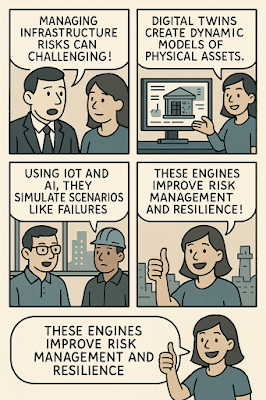How to Offer Digital Twin Risk Simulation Engines for Infrastructure
How to Offer Digital Twin Risk Simulation Engines for Infrastructure
Infrastructure systems — from bridges and power grids to water networks and airports — are the backbone of modern society.
But they are increasingly exposed to risks such as aging assets, climate change, and cyberattacks.
Digital twin risk simulation engines offer a cutting-edge solution, creating virtual replicas of physical infrastructure that allow operators to simulate scenarios, forecast failures, and make data-driven decisions to reduce risk and optimize performance.
Table of Contents
- What Are Digital Twins?
- Benefits of Risk Simulation Engines
- Core Components of the Engine
- Steps to Develop and Offer the Solution
- Future Trends in Digital Twin Technology
What Are Digital Twins?
A digital twin is a dynamic virtual model of a physical asset, system, or process.
It uses real-time data from sensors, historical records, and engineering models to mirror the state, behavior, and performance of its physical counterpart.
Digital twins allow infrastructure managers to test scenarios without risk, anticipate maintenance needs, and improve asset utilization.
Benefits of Risk Simulation Engines
Offering risk simulation capabilities within a digital twin unlocks powerful advantages:
- Predict potential failures and minimize downtime
- Optimize maintenance schedules and extend asset life
- Simulate natural disasters, cyber incidents, or operational disruptions
- Enhance regulatory compliance and safety
- Improve investment and budget planning
These benefits translate into cost savings, improved resilience, and better service delivery.
Core Components of the Engine
Successful digital twin solutions typically include:
- 3D/4D digital models of physical infrastructure
- IoT sensors and edge devices for real-time data collection
- AI/ML analytics engines for predictive insights
- Simulation modules for scenario planning and risk assessment
- User dashboards for visualization, alerts, and reporting
Steps to Develop and Offer the Solution
Start by partnering with asset owners, engineers, and technology providers to map system requirements.
Choose scalable platforms that support cloud, edge, and hybrid deployments.
Integrate physics-based models with real-time operational data and AI-based predictions.
Develop an intuitive user interface to make simulations accessible to technical and nontechnical stakeholders.
Pilot the system with a select set of assets, gather feedback, and refine the platform before scaling.
Future Trends in Digital Twin Technology
Looking ahead, digital twin innovation will be driven by:
- Integration with blockchain for data integrity
- Augmented reality (AR) interfaces for immersive visualization
- Federated twins combining multiple asset models into system-wide simulations
- AI agents capable of autonomous decision-making
By investing in cutting-edge digital twin tools, companies can future-proof their infrastructure management strategies.
External Resources
– Access global standards and case studies.
– Explore tools for 3D modeling and simulation.
– Learn about infrastructure-focused digital twins.
– Access cloud-based digital twin services.
– Discover industrial-grade digital twin platforms.
Important keywords: digital twin, risk simulation, infrastructure management, predictive analytics, IoT
